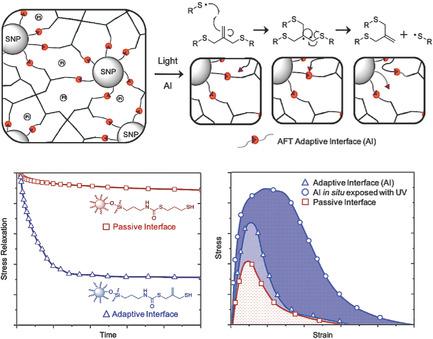当前位置:
X-MOL 学术
›
Adv. Mater. Interfaces
›
论文详情
Our official English website, www.x-mol.net, welcomes your
feedback! (Note: you will need to create a separate account there.)
Dynamic Covalent Chemistry at Interfaces: Development of Tougher, Healable Composites through Stress Relaxation at the Resin–Silica Nanoparticles Interface
Advanced Materials Interfaces ( IF 4.3 ) Pub Date : 2018-07-03 , DOI: 10.1002/admi.201800511 Nancy Sowan 1 , Christopher N Bowman 1 , Lewis M Cox 2 , Parag K Shah 3 , Han Byul Song 3 , Jeffrey W Stansbury 3
Advanced Materials Interfaces ( IF 4.3 ) Pub Date : 2018-07-03 , DOI: 10.1002/admi.201800511 Nancy Sowan 1 , Christopher N Bowman 1 , Lewis M Cox 2 , Parag K Shah 3 , Han Byul Song 3 , Jeffrey W Stansbury 3
Affiliation

|
The interfacial region in composites that incorporate filler materials of dramatically different modulus relative to the resin phase acts as a stress concentrator and becomes a primary locus for composite failure. A novel adaptive interface (AI) platform formed by coupling moieties capable of dynamic covalent chemistry (DCC) is introduced to the resin–filler interface to promote stress relaxation. Specifically, silica nanoparticles (SNP) are functionalized with a silane capable of addition fragmentation chain transfer (AFT), a process by which DCC‐active bonds are reversibly exchanged upon light exposure and concomitant radical generation, and copolymerized with a thiol‐ene resin. At a fixed SNP loading of 25 wt%, the toughness (2.3 MJ m−3) is more than doubled and polymerization shrinkage stress (0.4 MPa) is cut in half in the AI composite relative to otherwise identical composites that possess a passive interface (PI) with similar silane structure, but without the AFT moiety. In situ activation of the AI during mechanical loading results in 70% stress relaxation and three times higher fracture toughness than the PI control. When interfacial DCC was combined with resin‐based DCC, the toughness was improved by 10 times relative to the composite without DCC in either the resin or at the resin–filler interface.
中文翻译:

界面处的动态共价化学:通过树脂-二氧化硅纳米粒子界面处的应力松弛开发更坚韧、可修复的复合材料
复合材料中的界面区域含有相对于树脂相模量显着不同的填充材料,充当应力集中器并成为复合材料失效的主要场所。由具有动态共价化学(DCC)能力的偶联部分形成的新型自适应界面(AI)平台被引入树脂-填料界面以促进应力松弛。具体来说,二氧化硅纳米颗粒(SNP)用能够加成断裂链转移(AFT)的硅烷进行功能化,通过该过程,DCC活性键在光照和伴随自由基生成时可逆交换,并与硫醇烯树脂共聚。在 SNP 负载量固定为 25 wt% 时,与具有被动界面的其他相同复合材料相比,AI 复合材料的韧性 (2.3 MJ m -3 ) 增加了一倍以上,聚合收缩应力 (0.4 MPa) 减少了一半( PI)具有类似的硅烷结构,但没有 AFT 部分。机械加载过程中 AI 的原位激活可实现 70% 的应力松弛,断裂韧性比 PI 控制高出三倍。当界面 DCC 与树脂基 DCC 结合时,无论是在树脂中还是在树脂-填料界面,韧性比不含 DCC 的复合材料提高了 10 倍。
更新日期:2018-07-03
中文翻译:

界面处的动态共价化学:通过树脂-二氧化硅纳米粒子界面处的应力松弛开发更坚韧、可修复的复合材料
复合材料中的界面区域含有相对于树脂相模量显着不同的填充材料,充当应力集中器并成为复合材料失效的主要场所。由具有动态共价化学(DCC)能力的偶联部分形成的新型自适应界面(AI)平台被引入树脂-填料界面以促进应力松弛。具体来说,二氧化硅纳米颗粒(SNP)用能够加成断裂链转移(AFT)的硅烷进行功能化,通过该过程,DCC活性键在光照和伴随自由基生成时可逆交换,并与硫醇烯树脂共聚。在 SNP 负载量固定为 25 wt% 时,与具有被动界面的其他相同复合材料相比,AI 复合材料的韧性 (2.3 MJ m -3 ) 增加了一倍以上,聚合收缩应力 (0.4 MPa) 减少了一半( PI)具有类似的硅烷结构,但没有 AFT 部分。机械加载过程中 AI 的原位激活可实现 70% 的应力松弛,断裂韧性比 PI 控制高出三倍。当界面 DCC 与树脂基 DCC 结合时,无论是在树脂中还是在树脂-填料界面,韧性比不含 DCC 的复合材料提高了 10 倍。











































 京公网安备 11010802027423号
京公网安备 11010802027423号